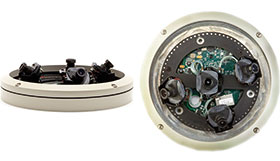

The market’s long-established dependence on analogue systems has contributed to a view that transitioning is just too difficult an obstacle to overcome.

Misconceptions can cloud the thinking of systems integrators and users alike when it comes to the application of IP video systems and megapixel cameras.
One of the biggest misconceptions deals with costs: There is concern that IP-based and/or megapixel video surveillance systems are expensive, but that doesn’t take into consideration the return on investment (ROI) and performance benefits they deliver.
Infrastructure and cabling are another concern, complicated by the perceived challenges of installing systems in larger deployments. However, the fact is that IP systems, especially those that leverage the benefits of megapixel imaging, are cost-competitive with analogue systems. In many cases, systems can actually cost less while providing better image quality, performance and functionality.
These systems also require less cabling and infrastructure, and can sometimes be deployed on existing networks. The immediate task at hand is to address and eliminate common misconceptions about IP megapixel systems so security professionals will more readily embrace the benefits of networked systems.
Crunching the numbers
Megapixel cameras provide real value and measurable cost-efficiencies for both end users and integrators. The most evident value is in the superior images produced by multi-megapixel cameras. Since the infancy of video surveillance, users have continually asked for better image quality. Now that quality is available with cameras that employ1.3 MP, 2 MP, 3 MP, 5 MP, 10 MP, 20 MP even 40 MP image sensors. By standard definition, conventional IP and analogue cameras produce about 400 000 pixels versus 1 300 000 to 40 000 000 pixels for megapixel cameras, and the difference in image definition is clearly visible. With megapixel cameras, zooming in after event provides forensic capabilities not possible with standard definition cameras.
Additional benefits of video surveillance systems with megapixel cameras include:
1. Fewer cameras, housings, cables, electrical wiring, and installation costs: Because megapixel cameras can cover a much wider field of view, far fewer cameras are typically required to cover the same area of surveillance.
For example, a large telecommunications company had originally designed a video surveillance system for its retail operations with 30 analogue cameras and was able to reduce the number to 17 total megapixel cameras without any compromises in coverage area.
Networked infrastructure uses fewer cables than analogue systems by eliminating the need to run separate cables from each camera to a DVR. Power-over-Ethernet (PoE) also supplies camera power over the same cable that connects to the network, eliminating the need for local power supplies and further simplifying installation costs.
2. High-definition megapixel cameras provide better forensic video: Highly detailed images recorded from megapixel cameras can be easily and quickly viewed, analysed and used by law enforcement/security authorities for investigation and prosecution. The HD quality images captured by megapixel cameras can aid in prosecutions, convictions, or even prove innocence. Conventional IP and analogue cameras simply cannot deliver the same level of image definition.
3. Better camera resolution can help reduce manpower costs: Megapixel cameras can sometimes replace the need for manned security services. In one school system, for example, megapixel cameras replaced security guards services while providing 24/7 coverage. The overall cost of the system was roughly equivalent to the money spent on guards over the course of a single year. So, the system was almost free of charge.
4. Digital PTZ: The use of ‘digital’ pan-tilt-zoom (PTZ) allows users far better coverage of facilities. Whether viewing a parking lot or a casino floor, a mechanical PTZ camera can only watch one of 10 fields-of-view it surveys at a time. That leaves nine fields-of-view without coverage. Covering those additional fields with additional cameras increases the overall costs. Megapixel single sensor and panoramic (multi-imager) cameras capture the entire scene, all the time, and users can zoom in on any area of the image, live or on recorded video. Having operators manually position PTZ cameras is not an efficient solution and is very costly.
Understanding the facts
There has been a great deal of progress in multi-megapixel video security systems in the last five years. Perhaps the greatest impact has come as security system platform providers have embraced the H.264 and now H.265 video compression standard, which significantly reduces network bandwidth and storage requirements of megapixel video. H.264 compression produces high-quality video using less bandwidth than the commonly used JPEG compression.
There are many metrics of video quality, some objective and some subjective. Using any measure, one can precisely demonstrate that when the compression parameters of the H.264 and JPEG standards are matched, the video quality of the same scene under like conditions is virtually indistinguishable across a wide range of settings, with the possible exception of the extreme high-compression limit.
The main difference between H.264 and JPEG is the consumed bandwidth per given video quality – H.264 offers a major reduction in bandwidth relative to JPEG. Bandwidth reduction translates to a major reduction in cost of security installations; the requirements for networking equipment and disk storage are accordingly reduced.
Reduction of bandwidth is achieved at the cost of high computational complexity of the H.264 encoder, which is used inside the camera. Put simply, the more computation there is, the more efficiently the data is organised and ‘packed.’ Decoding the compressed video stream is an entirely different matter. The H.264 standard is asymmetrical: all of its computational complexity is on the encoder side while the H.264 decoder is similar in complexity to a JPEG decoder. For example, Arecont Vision’s megapixel IP cameras use a patent-pending massively parallel H.264 hardware encoder that achieves 80 billion operations per second.
A common myth about H.264 is its so-called ‘hidden cost,’ an erroneous belief that because the computational complexity of the H.264 encoder is very high, the required decoder resources must be high as well, many times higher than required for JPEG. The ‘hidden cost’, as the theory goes, is in the additional computer server power needed to decompress multiple H.264 video streams in a multi-camera security installation in order to display live video from multiple cameras. This ‘hidden cost’ is alleged to be especially high for megapixel cameras.
In reality, the exact opposite is true: H.264 streams encoded by Arecont Vision cameras require less computational power to decompress than JPEG streams, a fact that has been demonstrated on brand-name and open-source H.264 software decoders, such as Intel IPP and FFMPEG used by major NVR manufacturers.
Better images everywhere
Megapixel imaging is the new benchmark in image quality and functionality for video surveillance systems now and in the future. Obstacles related to bandwidth and storage have been eliminated with H.264 compression. Price issues have also been addressed relative to the higher performance of megapixel cameras and their overall improved ROI versus conventional IP and analogue cameras. Integrators and users continue to overcome misconceptions with knowledge, push fear and hesitation aside, and are joining scores of security professionals in markets all over the world to embrace the numerous attributes of megapixel video.

© Technews Publishing (Pty) Ltd. | All Rights Reserved.